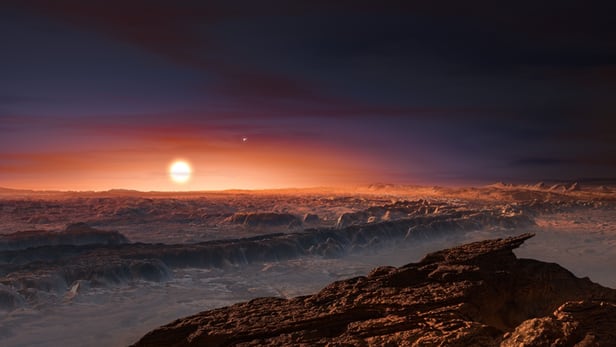
Proxima Centauri is classified as a red dwarf. Considered to be relatively small and cool compared to our own Sun, red dwarfs are the most common form of star populating the Milky Way. Despite their diminutive nature, it is thought that planets orbiting in the habitable zones (HZs) of red dwarfs are capable of sustaining life.
A HZ is essentially a region of space surrounding a star in which an orbiting rocky planet can maintain liquid water on its surface. Since water is thought to be one of the key ingredients for the evolution of life, Earth-sized planets orbiting in these regions are a prized target for astronomers looking for extraterrestrial life. The HZ of a red dwarf is much closer to the star's surface when compared to that of a stellar body such as our own Sun.
The discovery of the exoplanet, which has been named Proxima b, was made thanks to an international effort known as the Pale Red Dot campaign. Named in reference to the reddish hue of light thrown off by Proxima Centauri, and as a tribute to Carl Sagan's moniker for Earth as the "pale blue dot," the campaign was formed to keep an eye on our Sun's closest neighbor, in the hope of spotting an orbiting Earth-like exoplanet.
For the first half of 2016, Proxima Centauri was regularly monitored by a host of observatories spread across the globe. These telescopes, including the ESO's 3.6 m (11.8 ft) telescope located at the La Scilla observatory, Chile, were searching for minute wobbles that would serve as proof that the red dwarf was being disturbed by the gravitational influence of an orbiting exoplanet.
The first detection of Proxima b occurred in 2013, however the evidence was not sufficient to clearly point to the existence of the exoplanet. The intensive observations carried out in 2016 under the Pale Red Dot effort were more successful, providing clear evidence that the star was indeed wobbling through space. At points, the red dwarf was observed traveling back towards Earth at a rate of 5 km per hour (3.1 miles per hour), and then away from our planet at the same pace. This cycle continued once every 11.2 days.
An analysis of the 2013 readings in conjunction with the Pale Red Dot observations of Proxima Centauri's wobble and light signature, provided clear evidence for the existence of Proxima b. It is estimated that the exoplanet has a mass 1.3 times that of Earth, and orbits its star at a distance of 7 million km (4.3 million miles), placing it well inside the HZ of a red dwarf star.
"I kept checking the consistency of the signal every single day during the 60 nights of the Pale Red Dot campaign" commented Dr Guillem Anglada-Escudé, one of the lead astronomers behind the Pale Red Dot campaign hailing from Queen Mary University, London. "The first 10 were promising, the first 20 were consistent with expectations, and at 30 days the result was pretty much definitive, so we started drafting the paper!"
So, could this newfound planet, which orbits its star at only 5 percent the distance between the Earth and Sun actually be habitable?
Ultimately, we do not yet know. It is estimated that the surface temperature is conducive to the presence of liquid water, but that the environment may have been radically altered from anything we know here on Earth as a result of its disparate formation history, and the intense radiation pouring out from the nearby red dwarf.
Furthermore, it is possible that the planet is rotationally locked to its star. This means that one face of the world is bathed in perpetual daylight, and the other in constant night. According to one of the papers published on the discovery of Proxima b, if the exoplanet were to be rotationally locked, liquid water would likely only exist on the side bathed in sunlight. If the exoplanet's orbit is not locked, then it is thought that water could only endure in a tropical belt.
There are numerous reasons that have been given as to why life could not evolve on the planet. It has been suggested that Proxima b does not experience seasons, and that the atmosphere could be fundamentally different to our own, assuming that it hasn't evaporated away into space. On the bright side, none of these doom-and-gloom scenarios can be proven without direct observation of the planet, and this can only occur in the unlikely event that the exoplanet passes between Proxima Centauri and Earth.
Although it is extremely doubtful that this will happen, current and future Earth-bound and orbital telescopes will watch for just such an occurrence, which would allow astronomers to glean an understanding of the composition of Proxima b's atmosphere.

 Previous page
Previous page Back to top
Back to top







